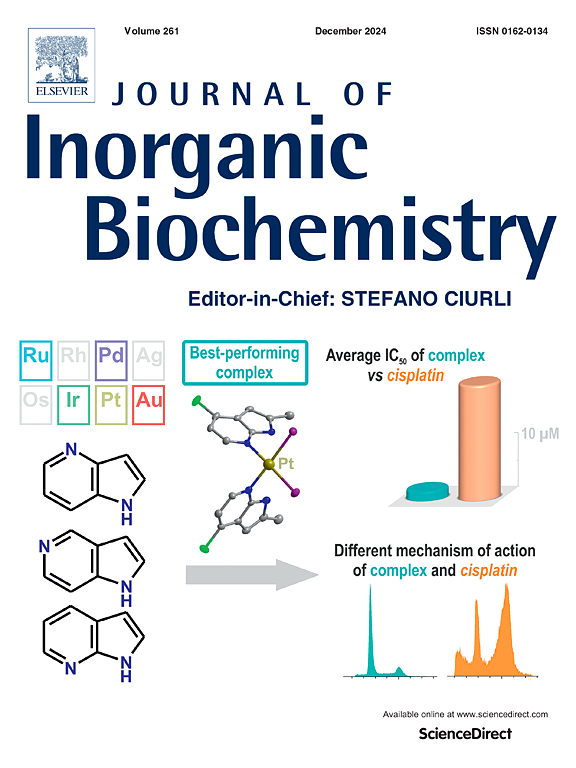Synthesis, crystal structure, computational and solution studies of a new phosphotetradecavanadate salt. Assessment of its effect on U87 glioblastoma cells
IF 3.8
2区 化学
Q2 BIOCHEMISTRY & MOLECULAR BIOLOGY
引用次数: 0
Abstract
The new benzylammonium (C7H10N) salt of the phosphotetradecavanadate (PV14) anion PV14O429−, (C7H10N)6[H3PV14O42]∙7H2O (1), is synthesized under mild conditions and characterized by a combination of physicochemical techniques such as Fourier transform infrared spectroscopy, powder X-ray diffraction, elemental analyses and cyclic voltammetry. As evaluated by 51V NMR spectroscopy, at milimolar concentrations and pH ∼2.5 the PV14 anions decompose slowly, thus demonstrating kinetic stability, but at pH ∼7 this process takes place much faster. However, in the presence of human serum albumin, the 51V NMR peaks of PV14 anions broaden significantly and their decomposition becomes much slower, this being due to a direct interaction between both components. The structure of 1 is elucidated by single-crystal X-ray diffraction and reveals the presence of three-fold protonated, bicapped Keggin type [H3PV14O42]6− anions. The supramolecular interactions governing the crystal packing are further studied using the Hirshfeld surface analysis. Computational studies using density functional theory were effective in determining the electronic and protonation states of PV14 clusters, as well as the multi-electron redox behavior of compound 1 in acidic aqueous solutions. Molecular dynamics calculations confirm the high hydrophilicity and absence of aggregation between protonated PV14 anions in aqueous medium. Notably, this compound shows high inhibitory effect on the viability of the U87 glioblastoma cell line with IC50 values of 3.2 ± 0.6 μM and 1.10 ± 0.04 μM after 24 h and 72 h treatments. The mode of action of compound 1 is mediated by the pro-apoptotic process. These data provide evidence on the potential therapeutic use of PV14 compounds against glioblastoma.

一种新型磷十四烷酸盐的合成、晶体结构、计算及溶液研究。对U87胶质母细胞瘤细胞的影响
在温和条件下合成了磷酸十四烷酸(PV14)阴离子PV14O429−的新型苯铵(C7H10N)盐,(C7H10N)6[H3PV14O42]∙7H2O(1),并结合傅里叶变换红外光谱、粉末x射线衍射、元素分析和循环伏安法等物理化学技术对其进行了表征。通过51V核磁共振波谱评估,在毫摩尔浓度和pH ~ 2.5下,PV14阴离子分解缓慢,因此表现出动力学稳定性,但在pH ~ 7下,这一过程发生得更快。然而,在人血清白蛋白的存在下,PV14阴离子的51V核磁共振峰明显变宽,分解速度变慢,这是由于两者之间的直接相互作用。单晶x射线衍射证实了1的结构,发现存在三重质子化、双切Keggin型[H3PV14O42]6−阴离子。利用Hirshfeld表面分析进一步研究了控制晶体堆积的超分子相互作用。利用密度泛函理论的计算研究可以有效地确定PV14簇的电子和质子化状态,以及化合物1在酸性水溶液中的多电子氧化还原行为。分子动力学计算证实了质子化PV14阴离子在水介质中的高亲水性和无聚集性。该化合物对U87胶质母细胞瘤细胞株的抑制作用显著,作用24 h和72 h的IC50分别为3.2±0.6 μM和1.10±0.04 μM。化合物1的作用方式是通过促凋亡过程介导的。这些数据为PV14化合物治疗胶质母细胞瘤的潜在应用提供了证据。
本文章由计算机程序翻译,如有差异,请以英文原文为准。
求助全文
约1分钟内获得全文
求助全文
来源期刊

Journal of Inorganic Biochemistry
生物-生化与分子生物学
CiteScore
7.00
自引率
10.30%
发文量
336
审稿时长
41 days
期刊介绍:
The Journal of Inorganic Biochemistry is an established international forum for research in all aspects of Biological Inorganic Chemistry. Original papers of a high scientific level are published in the form of Articles (full length papers), Short Communications, Focused Reviews and Bioinorganic Methods. Topics include: the chemistry, structure and function of metalloenzymes; the interaction of inorganic ions and molecules with proteins and nucleic acids; the synthesis and properties of coordination complexes of biological interest including both structural and functional model systems; the function of metal- containing systems in the regulation of gene expression; the role of metals in medicine; the application of spectroscopic methods to determine the structure of metallobiomolecules; the preparation and characterization of metal-based biomaterials; and related systems. The emphasis of the Journal is on the structure and mechanism of action of metallobiomolecules.
 求助内容:
求助内容: 应助结果提醒方式:
应助结果提醒方式:


